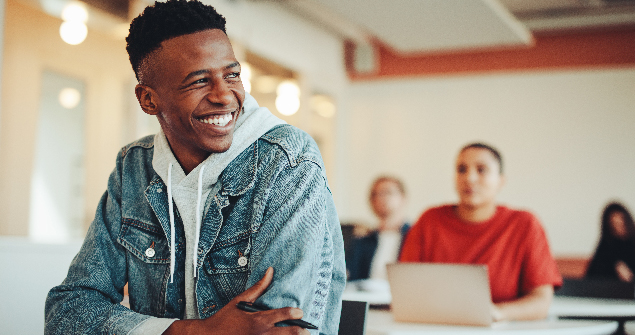In the wake of the pandemic, many of the nation’s school districts are using ESSER and EANS funds to prioritize student mental health. That’s why it’s important to consider how a room’s furnishings and layout can impact a student’s mental outlook.
Research has shown that many interior (and exterior) design approaches can reduce stress and depression. Even basic changes to a room’s design – like using cool-toned colors or furnishings that promote collaboration – can make a big difference to a student’s well-being.
Explore our proven tips on how your school can use its ESSER or EANS funds to design spaces that leave students feeling happier and healthier.
Give access to light & nature
Time spent outdoors is highly beneficial for students’ mental, physical and social health. When students learn outdoors, for example, they are often calmer, better able to focus and more enthusiastic, thanks to an immediate boost in serotonin from sunlight. Prioritizing the time students spend outdoors learning, socializing or playing is a sure-fire way to boost mental health.
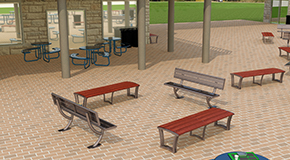
- Far apart benches or picnic tables offer students more personal space.
- Access to shade structures like umbrellas keep students comfortable on hot days.
- Furnishings made with weather-resistant materials like plastic withstand the seasons.

- Lightweight seating like stumps or stacking stools are easy for students to arrange.
- Sandboxes, water tables or activity panels add fun sensory experiences.
- Picnic tables with smooth tops allow students to work and are a cinch to clean.

- Designated age areas or energy level sections help keep students safe.
- Multiple types of play such as active or sensory help keep students engaged.
- Inclusive designs ensure students of all abilities can use the playground.
Give access to refuge & personal space
Tranquility rooms, breakout rooms and individual nooks are all spaces that can offer students a reprieve from anxious or stressful situations. These spaces are often dedicated quiet spots that offer privacy or access to calming devices such as fidget spinners, stress balls and coloring books to aid in de-escalation.

- Soft seating like oversized bean bag chairs and floor rockers keep students comfortable.
- Cool-toned colors like blues, greens and greys offer a peaceful feel.
- Spacious tabletops allow students to partake in de-escalating activities like journaling.

- Designed to function as a safe space in moments of embarrassment or stress.
- Tinted glass or portable room panels allow for instant privacy.
- Storage space for personal belongings adds functionality.

- Allow students to get away from the crowd without being totally alone.
- Mobile study carrels offer private, portable workspace.
- Moveable, sound-absorbing room partitions can reconfigure space for privacy.
Promote social interaction
It’s no secret that social interaction is critical to mental and physical well-being, regardless of age. Studies show that socializing fends off feelings of loneliness and depression, improves self-esteem and even sharpens memory and cognitive skills. Promote student interaction by outfitting centralized common areas, comfortable activity spaces and flexible dining rooms.
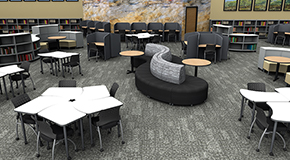
- Work well in unused, centralized spaces like hallways, entryways or locker areas.
- Structured soft seating gives students comfortable, portable hang out spots.
- Whiteboard tables encourage impromptu brainstorming and notetaking.

- Flexible seating like wobble stools or mobile chairs encourage quick collaboration.
- Mobile charging carts for laptops or tablets keep the space tech friendly.
- Collaborative tables can be pushed together or pulled apart as needed.

- Variety of seating options give students a feeling of ownership over where they sit.
- Access to power and other media make a dining space that’s multi-purpose.
- Outdoor dining options offer students the health benefits of sunlight and fresh air.
Allow access to caring adults
Studies show that students who have access to caring adults in school – like a counselor, tutor or nurse – engage in less risky behavior, have increased levels of motivation and higher psychological well-being. Be sure your school’s resource room, counselor’s room or nurses' office is equipped with the furnishings necessary for successful visits.
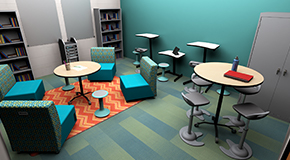
- A multi-purpose space designed for small group work, tutoring sessions or counseling.
- Mobile activity tables make collaboration a cinch.
- Mobile charging carts keep laptops or tablets up and running.

- Kid-friendly wall art, stickers or coloring books make students feel more at ease during visits.
- Vinyl treatment beds provide a place for students to rest comfortably.
- A mobile stool provides quick and easy maneuverability.
Allow students to explore self-efficacy
Learning spaces that allow students to embrace their autonomy can boost their self-esteem and leave them feeling empowered to take on more challenging goals. Makerspaces, music rooms and art rooms are all examples of spaces that promote the growth of self-efficacy through risk-taking, creativity, experimentation and more.
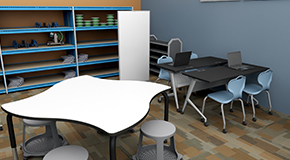
- Ample, heavy-duty workspace allows students to build and experiment comfortably.
- Restricted areas help keep students safe from potentially dangerous machines.
- Mobile storage carts with removable bins keep supplies accessible and organized.

- Music chairs support students’ posture and breathing as they practice.
- A music-lined markerboard provides space for students to write and share music.
- Colorful, music-themed rugs instantly brighten the space.

- Colorful, flexible seating, like plastic stacking stools, create a space that’s inviting.
- Multiple bulletin boards provide space to display student artwork.
- A portable sink makes it quick and easy for students to wash up after projects.
Furnishings we recommend
around your specific
educational goals.
seamlessly handle every step of
your project, no matter its size.
your after-order logistics like
delivery and installation.
Call 1-800-260-2776 or with a specialist now.

No time for a phone call?

Prefer to leave a message?



